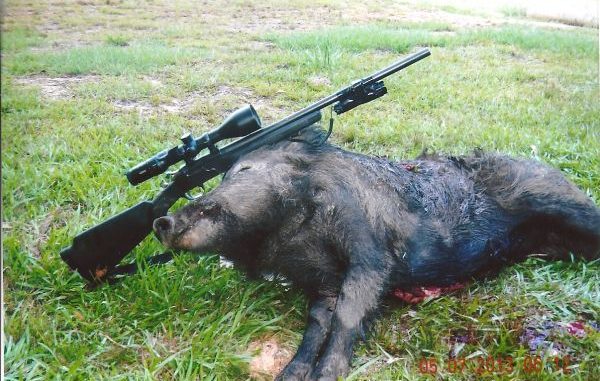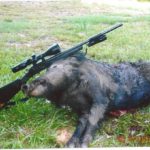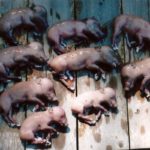
Since the Robertson Clan has cornered the market on the phrase “Happy, happy, happy” (Papa Phil has even written a book by that name), I decided the title for my column this month would be “Good, good, good” in reference to the good things that have recently happened in our wildlife management program in Clinton.
Most of the time “happy” is an adjective that describes a person’s feelings of good fortune, but sometimes our dogs have a happy look on their face.
“Good” is another adjective that can describe how a person feels, but it is also used for non-human and non-living objects. For example I might say that is a good horse or this is a good gun that does not kick.
In last month’s issue I talked about the work that needs to be done now so that one can have hunting success this fall. One work item I mentioned was the control of feral hogs. The June/July issue of Quality Whitetails (a magazine produced by the QDMA) had a short blurb that deer actively avoid hogs, and that hogs can exclude deer from food sources such as food plots and feeders.
Control of feral hogs is a year-round activity, and I am constantly monitoring sites where I see evidence of hogs and their feeding activity. Hogs have been rooting in the clover and chicory forage strips; I have written in the past how hogs will graze the arrowleaf clover just like deer. While this feeding activity is not tearing up the strips, the fact that they are coming regular provides opportunity to harvest a hog.
The other night I drove up to Clinton following a meeting in Plaquemine, arriving on the property around 10 p.m. I unloaded my truck and got gear organized, and then slipped out to the big field.
I eased up to the strip where most of the activity was occurring and turned the Q-Beam on. I thought I saw a black object with a faint glow of eyes, so I turned the light off.
I have attached a light underneath the barrel of my .444 that will project a beam 75 yards or so. I turned the light on and raised the rifle; sure enough the black object was a hog, and I quickly got a sight picture and fired.
I thought I heard the sound of a pig running off, but I could see movement in the clover and grass where the hog had been standing. Easing over, I saw a nice, large hog on the ground that was making a few final movements with its hind legs. My shot was a little back from the head; usually I aim for the base of the skull. The bullet had hit the spine just above the front shoulders, dropping the hog immediately and causing severe hemorrhaging.
I went and got the John Deere and hooked the hog up. Before moving, I collected a few tubes of blood to give to LDWF for disease testing.
I dragged the hog to the camp and gutted it, placed a 20-pound bag of ice in the cavity, and then covered it with a tarp. I noticed that when I removed the uterus that the hog was pregnant.
The next morning I was up early, finishing the job and packing the meat on ice. I checked the uterus and found that the hog had nine piglets in its uterus.
According to the literature hogs are pretty prolific. A sow can become sexually mature before a year of age, and an adult female can breed twice a year, with a litter size ranging from four to 12 pigs. The gestation period is not quite four months (a deer is seven months).
These fetal pigs were the size of a good hand-sized bluegill, and I am thinking she was about a month away from birthing them. When I told people about killing the hog, the common comment from all of them was, “that was a good kill,” “that was a good one to get,” “you did good.”
Good, good, good.
My feral hog control program is working, plus I am putting pork in the freezer. This sow was a mature adult and had a full set of permanent teeth, but they were not showing a lot of wear, so the sow was probably 2 to 3 years old, and based on the number of fetuses was a good breeder.
I checked the stomach and found one large earthworm along with much plant matter, so I guess the rooting is in search of worms.
Indeed, this was a good hog to remove from the population, and perhaps I have helped reduce the population on the property; at least the hog activity has been curtailed for the time being.
The more I mess with feral hogs the more convinced I am that they are some pretty sharp creatures to pit your wits against, which is why I enjoy our unrestricted season. With their ability to reproduce, we are probably losing this war — which is why it is so important to take a proactive approach to your control program and work hard to try and keep numbers under control.
It has been a wet spring, and I have spent a few days looking at the deer browse situation. What I am seeing looks good, good, good.
I did a browse survey in the Morganza Floodway in May; if you recall, this area of the state was underwater at this time in 2011, and there was concern for the deer population.
From what I found there is no problem with the deer population whatsoever. Browse availability was excellent, and browsing activity was high. Deer were eating the desired species, such as blackberry and trumpet creeper.
At one location I found over 100 stems of giant ragweed that had been browsed by the deer. This particular tract of land is hunted much harder than most lands within the floodway, and it is apparent that the hunting has not hurt this population of deer at all.
When the browse is excellent, deer growth and development will be good along with reproduction and fawn recruitment.
Browse availability and utilization is also good on the Clinton tracts. The 30-acre clearcut has become a 30-acre food plot. Blackberry was again the browse species that is being heavily eaten along with oak, maple and elm.
The food plots were planted just prior to the heavy rain that fell in May and now we have cowpeas popping up out of the ground, and if we get more rain will really enhance the nutrition for the deer. I am putting together a story for an upcoming magazine issue concerning the deer browse in old-fashioned cutovers.
The timber management that is being applied today in our piney woods does not produce the browse like it once did. I am hoping that the excellent browse availability we have will result in a good deer season.
Yep, things so far are good, good, good.




